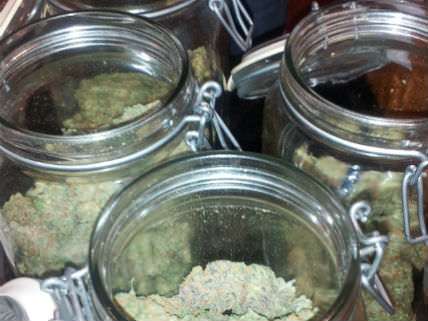Brookings Report Decries the Federal Government's 'War on Medical Marijuana Research'
Practical suggestions for making it easier to investigate the therapeutic properties of cannabis

Drug policy reformers have long complained that the federal government keeps marijuana in Schedule I of the Controlled Substances Act, the law's most restrictive category, because it considers the evidence of the drug's medical utility inadequate but at the same time makes it very difficult to conduct the research needed to justify reclassification. In a new Brookings Institution report, John Hudak and Grace Wallack describe in detail the bureaucratic barriers to medical marijuana research, which they deem "inexcusabl[e]" in light of the need for more information about the therapeutic properties of a plant that is legally used for symptom relief by more than 1 million patients across the country. Hudak and Wallack argue that "ending the U.S. government's war on medical marijuana research" is good politics as well as good policy.
As Hudak and Wallack note, marijuana's Schedule I status, which supposedly hinges on its lack of "currently accepted medical use," is itself a barrier to research, since it imposes an extra regulatory burden on scientists and discourages image-conscious institutions from sponsoring studies. They say "moving marijuana from Schedule I to Schedule II"—which could be done by Congress or by the attorney general in consulation with the Department of Health and Human Services—"would signal to the medical community that FDA and NIH are ready to take medical marijuana research seriously, and help overcome a government-sponsored chilling effect on research that manifests in direct and indirect ways."
Hudak and Wallack say some benefits of rescheduling could be realized without reclassifying marijuana by reforming licensing and certification requirements. They also recommend breaking the federal monopoly on production of marijuana for research, which is done exclusively at the University of Mississippi under contract with the National Institute on Drug Abuse (NIDA). Unlike the practice with other Schedule I substances, the Drug Enforcement Administration refuses to license any other producers. Although NIDA recently expanded marijuana production and started offering a larger variety of strains to researchers, Hudak and Wallack say, "many argue that the quantity and diversity of marijuana produced by NIDA will be lacking relative to what multiple providers would offer."
The Obama administration this year eliminated another marijuana-specific research barrier: an extra layer of review by the U.S. Public Health Service that was not required for any other drug. NIDA's marijuana monopoly is open to the same objection: Why should marijuana be subject to restrictions that are not considered necessary for other substances in the same legal category, not to mention widely abused Schedule II substances such as cocaine, methamphetamine, and oxycodone?
Even as it denies marijuana's medical utility, the federal government implicitly acknowledges it by supplying NIDA's marijuana to patients under the Compassionate Investigational New Drug program. That program was closed to new applicants in 1992, and only four patients continue to receive Uncle Sam's joints every month. Hudak and Wallack suggest expanding the program would be one way to facilitate medical marijuana research—a proposal that also has been endorsed by former drug czar and staunch pot prohibitionist William Bennett.
As that example suggests, medical marijuana research is a cause with potentially wide appeal. In addition to Bennett and anti-pot activist Kevin Sabet, drug warriors such as Sens. Chuck Grassley (R-Iowa) and Dianne Feinstein (D-Calif.) have expressed interest in removing unnecessary barriers to research. Hudak and Wallack argue that "expanding research should be a cause championed by the most passionate pro-marijuana advocates as well as the most ardent drug warriors—and everyone in between":
If you believe that cannabis is an elixir that can be used to treat a variety of ailments with very few side effects or risks of overdose, then you should support the scientific community validating your perspective. Alternatively, if you believe cannabis is a gateway drug, inappropriatefor pharmaceutical (or any) use because it is a source of addiction and has no medicinal value, then you should also support a scientific validation of your views. Finally, if you believe cannabis' medicinal value is an open, unanswered, empirical question, then you should embrace the medical community's ability to provide definitive evidence.
Hudak and Wallack note that medical marijuana has brought together "strange bedfellows" in Congress and has broad popular support, with various polls indicating that 70 percent to 80 percent of Americans think patients should be able to obtain cannabis if their doctors think it could help them. Hudak and Wallack are puzzled by the apparent reluctance of presidential candidates to address the issue when they do not hesitate to stake out "bold positions on much more controversial topics including the Affordable Care Act, entitlement reform, foreign intervention, climate change, and immigration policy."
Since nearly two dozen states allow medical or recreational use of marijuana, the next president will have to address the issue. Hudak and Wallack argue that facilitating medical marijuana research would be a logical and politically safe way to begin. "Thousands of Americans use marijuana for medical purposes, and many do so legally in 23 states and the District of Columbia," they write. "Yet Congress and federal agencies continue to impede clinical research on the appropriate usage of marijuana. It's time to stop letting outdated policy prevent the scientific community from advancing knowledge and ensuring that patients and practitioners understand the benefits and risks of medical marijuana."


Show Comments (8)